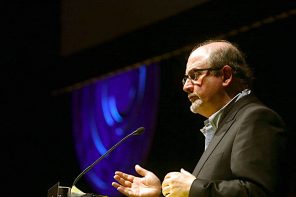The global religious landscape is changing, fast, and The Future of World Religions report from the Pew Research Center has boldly gone where no exceptionally long research group report has gone before by extrapolating current trends to draw a spiritual picture of the world in 2050.*
The report is careful to acknowledge that a lot could change between now and 2050. War, famine, pandemics, and general political instability, for example, could knock these trends off track given that the greatest driving factors for change are determined by age of the population, life expectancy, and fertility rates.
Topline findings—and the resulting headlines—are eye-catching enough, but so much is missed if you never make it past the summary. I’ve pored over all 245 pages so you don’t have to (you’re welcome) and discovered six fascinating tidbits beyond the 900-pound factoid in the room, that Islam will equal or surpass Christianity as the world’s largest religion.
1. Don’t Go West Young Man, Go South
The percentage of Christians living in sub-Saharan Africa is set to grow from 24% in 2010 to 38% in 2050. For the math-challenged among us, that means two out of every five Christians in the world will live in sub-Saharan Africa—a whopping 115% growth rate.
However that number becomes a bit less impressive when you consider that sub-Saharan Africa’s general population is projected to grow at the rate of 131% and growth in the Muslim population of the region is projected at 170%.
So while the global Christian population is shifting south, the Christian share of the population of sub-Saharan Africa may actually decrease.

A Dawoodi Bohra woman with children at the Mosque of Ibn Tulun in Egypt. Image via
Scott D. Haddow/Flickr.
2. The Year 2070 Means Muslim Plurality
For the first time ever (or perhaps just since sometime between 1000 and 1600 CE when The Plague decimated the European Christian population, according to footnote #2 of the report), in 2070 there will be more Muslims in the world than Christians.
Between 2010 and 2050 the Muslim population is projected to grow by 73%, far outpacing the total population growth rate of 35%. Islam is not likely to keep up that growth rate forever as fertility rates will likely decline over time.
But the trends are pretty clear: Christian global plurality will (probably) not last forever.
Bonus: while the Middle East or Africa would be an understandable guess, the largest Muslim population in the world by 2050 will actually be India.

2008 Summer Olympics – Opening Ceremony – Beijing, China 同一个世界 同一个梦想 – U.S. Army World Class Athlete Program – FMWRC. Photo via U.S. Army/Flickr
3. Because China: That Thing about Muslim Plurality in 2070 Might Not Actually Be True
The wild card that could sink item 2: China.
Five years ago, China’s Christian population was an estimated 65 million—just 5% of the country’s population of 1.3 billion—including the two sects of state-sanctioned Christian churches and rough estimates of those who belong to non-state-sanctioned or “underground” churches.
The truth is—and the Pew researchers admit as much—it’s really difficult to accurately estimate what percentage of China’s population is Christian. Because it accounts for such a large portion of the global population, the assumptions researchers make about China hold huge implications for the global numbers.
If researchers’ current models are correct, Christians would comprise about 31.4% of the global population by 2050. Similarly, if China turns out to be more like Japan—a deeply secular nation that is likely to grow increasingly more so—the Christian population worldwide would dip slightly, to 30.9%.
But if China is more like South Korea—another largely secular society but one that is seeing an increase in religious affiliation—then Christians would make up closer to 35.3% of the global village.
What if everyone in China who is currently unaffiliated were to become a Christian? That would bump the number to 38.5% of the world’s population. While that’s an unlikely scenario, China’s religious “unknowns” could tip the scales (by a margin of hundreds of millions) in favor of either the Christian or “unaffiliated” categories.
While the researchers don’t play all these scenarios out in relation to when Islam would overtake Christianity, a significant increase in the numbers of projected Christians would certainly push it back a few years. And since Islam will be increasing but at a decreasing rate, it might push that day off indefinitely.
4. “Nones” on the Rise Does Not Mean Religion Is in Decline (Particularly in the U.S.)
In 2010, researchers categorized as “unaffiliated” roughly 1.1 billion people worldwide, a number that’s likely to climb to 1.2 billion by 2040, before it begins to drop.
During the same period, the global population will be growing at a much faster rate, meaning that the “unaffiliated” portion of the population is likely to shrink from 16.4% in 2010 to 13.2% by 2050.
In other words, the “rise of the nones” does not spell the end of organized religion.
It’s important to note that the rejection of a belief in God or a higher power is not necessarily what it means to be “unaffiliated.” People reject religious labels for various reasons. Pew’s researchers point out that in a previous study, a full 68% of “unaffiliated” Americans still maintained a belief in God or a “higher power.” And more than half of those “unaffiliated” believed that churches and other religious communities tend to be a good thing for society.
While growth among the “unaffiliated” is primarily being fueled by North America and Europe, fully 76% of the religiously unaffiliated globally resided in the Asia-Pacific region in 2010, a figure that is expected to drop to 68% by 2050.
The “unaffiliated” group is rising much faster in North America than in Europe. Europe is projected to move from 19% to 23% of its population unaffiliated while North America would move from 17% to 26% (16% growth for Europe and 89% growth for US). Only in the Asia Pacific area is there expected to be a decline in the unaffiliated at 2% (82).
But it’s also not clear if being “unaffiliated” really means the same thing in the United States as elsewhere. Take that earlier number of 68% of the “unaffiliated” believing in God or a higher power in the United States.
That drops to 30% in France (233). According to that previous Pew research, one reason more people identify as “unaffiliated” now is that people who used to skip church and not really believe anything in particular simply felt a social pressure to identify with a religion anyway. Now, more people feel comfortable simply naming what they were already doing before.
 5. Eve May Have Stolen the Apple, but Adam is Leading the Exodus from Eden
5. Eve May Have Stolen the Apple, but Adam is Leading the Exodus from Eden
Of the 66 million people globally who are projected to switch their religious affiliation away from Christianity over the next 40 years, two-thirds (or 44 million) will be men. Meanwhile, nearly 43 million men are expected to end up in the “unaffiliated” category, compared to a projected 18 million women.
The “unaffiliated” category will benefit the most from the “switchers” with a net gain of 61.5 million, many of them men and women who formerly identified as Christian. But by 2050 the “unaffiliated” are expected to comprise an older (and less fertile) demographic that won’t be able to welcome new folks to their team fast enough to sustain that kind of growth in the long term, according to the report.
But statistics about religion switching (aka “sheep stealing” in some traditions) sound more nefarious than they are as the switching doesn’t actually alter the global numbers very much. If you subtract “switching” from the report’s calculations, over the next 40 years, the Christian population is only projected to grow by one percent (from 31% to 32% of the global population.)
Meanwhile, religious “switching” has no projected discernible effect on the global Muslim population, with only a modest .2% decline in the Muslim population of the United States.
6. The Leftovers: Hot HBO Drama or Hot New Religious Trend?
The rapid growth of those no longer affiliated with any religious tradition deserves our attention, but perhaps not for the reasons repeated by the prevailing cultural narrative. In fact, the “rise of the nones” story is obscuring news of a different, equally fascinating trend in the world of religion.
While small in total number, the fastest growing religious population in North America today (after Islam) is NOT the “nones”
It’s “other religion,” a category that includes anything from Baha’i and Taosim to Wicca and Zoroastrianism.
Part of the growth in “other religion” segment is being fueled by religion-switching. Nearly 2 million people are expected to be added to the “other religion” category over the next generation or so by switching their allegiance from another religious tradition (or none). Islam, by comparison, is projected to gain to gain 3.2 million new adherents and “folk religions” (these tend to be small in number and tied to a particular people group or tribe) are likely to see gains of 2.6 million during the same time period.
Such numbers are miniscule compared to the projected 61.5 million expected to switch into the “unaffiliated” category by 2050, nevertheless the 197% projected growth rate should turn more than a few heads.
Something is causing people to be attracted to smaller, lesser known religious traditions. As they grow in size and prominence, “other religion’ could end up attracting a lot more of the “unaffiliated” folks than Pew’s researchers presently project.
A critical mass gained in any one of these smaller religious traditions could prove to be another wild card in the future of world religion.
*It’s important to note that, unlike many other reports of its kind, The Future of World Religion is based on religious self-identification, not adherence factors such as membership in a worshiping community or theological conviction.
Photo credits: Children praying in Malawi, Africa. Photo via Colin Carmichael/Flickr. A Dawoodi Bohra woman with children at the Mosque of Ibn Tulun in Egypt. Image via Scott D. Haddow/Flickr. 2008 Summer Olympics – Opening Ceremony – Beijing, China 同一个世界 同一个梦想 – U.S. Army World Class Athlete Program – FMWRC. Photo via U.S. Army/Flickr. “New Month’s Day—Snowdance” photo by Snugg LePupp/Flickr. Adam and Eve (oil on panel) by Lucas Cranach the Elder.”Wanderer” image by Alice Popkorn/Flickr.








